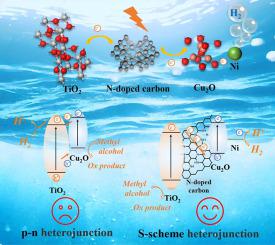当前位置:
X-MOL 学术
›
J. Mater. Sci. Technol.
›
论文详情
Our official English website, www.x-mol.net, welcomes your feedback! (Note: you will need to create a separate account there.)
Interface-induced charge transfer pathway switching of a Cu2O-TiO2 photocatalyst from p-n to S-scheme heterojunction for effective photocatalytic H2 evolution
Journal of Materials Science & Technology ( IF 10.9 ) Pub Date : 2024-03-02 , DOI: 10.1016/j.jmst.2024.01.034 Kaihui Huang , Guijie Liang , Shaolong Sun , Haobin Hu , Xiaoming Peng , Rongchen Shen , Xin Li
Journal of Materials Science & Technology ( IF 10.9 ) Pub Date : 2024-03-02 , DOI: 10.1016/j.jmst.2024.01.034 Kaihui Huang , Guijie Liang , Shaolong Sun , Haobin Hu , Xiaoming Peng , Rongchen Shen , Xin Li

|
Photocatalytic hydrogen evolution from water splitting is an appealing method for producing clean chemical fuels. CuO, with a suitable bandgap, holds promise as a semiconductor for this process. However, the strong photo-corrosion and rapid charge recombination of CuO strongly limit its application in the photocatalytic fields. Herein, an S-scheme heterojunction photocatalyst composed of TiO and CuO was rationally designed to effectively avoid the photo-corrosion of CuO. The introduction of an interfacial nitrogen-doped carbon (NC) layer switches the heterojunction interfacial charge transfer pathway from the p-n to S-scheme heterojunction, which avoids excessive accumulation of photogenerated holes on the surface of CuO. Meanwhile, the hybrid structure shows a broad spectral response (300–800 nm) and efficient charge separation and transfer efficiency. Interestingly, the highest photocatalytic hydrogen evolution rate of TiO-NC-3%CuO-3%Ni is 13521.9 μmol g h, which is approximately 664.1 times higher than that of pure CuO. In-situ X-ray photoelectron spectroscopy and Kelvin probe confirm the charge transfer mechanism of S-scheme heterojunction. The formation of S-scheme heterojunctions effectively accelerates the separation of photogenerated electron-hole pairs and enhances redox capacity, thereby improving the photocatalytic performance and stability of CuO. This study provides valuable insights into the rational design of highly efficient CuO-based heterojunction photocatalysts for hydrogen production.
中文翻译:

Cu2O-TiO2 光催化剂的界面诱导电荷转移路径从 pn 异质结切换到 S 型异质结,以实现有效的光催化析氢
从水分解中光催化析氢是生产清洁化学燃料的一种有吸引力的方法。 CuO 具有合适的带隙,有望作为该工艺的半导体。然而,CuO的强光腐蚀和快速电荷复合严重限制了其在光催化领域的应用。本文合理设计了由TiO和CuO组成的S型异质结光催化剂,有效避免了CuO的光腐蚀。界面氮掺杂碳(NC)层的引入将异质结界面电荷转移路径从pn异质结转变为S型异质结,避免了光生空穴在CuO表面的过度积累。同时,混合结构表现出宽光谱响应(300-800 nm)和高效的电荷分离和转移效率。有趣的是,TiO-NC-3%CuO-3%Ni的最高光催化析氢速率为13521.9 μmol·gh,比纯CuO高约664.1倍。原位X射线光电子能谱和开尔文探针证实了S型异质结的电荷转移机制。 S型异质结的形成有效加速了光生电子-空穴对的分离,增强了氧化还原能力,从而提高了CuO的光催化性能和稳定性。这项研究为合理设计用于制氢的高效 CuO 基异质结光催化剂提供了宝贵的见解。
更新日期:2024-03-02
中文翻译:

Cu2O-TiO2 光催化剂的界面诱导电荷转移路径从 pn 异质结切换到 S 型异质结,以实现有效的光催化析氢
从水分解中光催化析氢是生产清洁化学燃料的一种有吸引力的方法。 CuO 具有合适的带隙,有望作为该工艺的半导体。然而,CuO的强光腐蚀和快速电荷复合严重限制了其在光催化领域的应用。本文合理设计了由TiO和CuO组成的S型异质结光催化剂,有效避免了CuO的光腐蚀。界面氮掺杂碳(NC)层的引入将异质结界面电荷转移路径从pn异质结转变为S型异质结,避免了光生空穴在CuO表面的过度积累。同时,混合结构表现出宽光谱响应(300-800 nm)和高效的电荷分离和转移效率。有趣的是,TiO-NC-3%CuO-3%Ni的最高光催化析氢速率为13521.9 μmol·gh,比纯CuO高约664.1倍。原位X射线光电子能谱和开尔文探针证实了S型异质结的电荷转移机制。 S型异质结的形成有效加速了光生电子-空穴对的分离,增强了氧化还原能力,从而提高了CuO的光催化性能和稳定性。这项研究为合理设计用于制氢的高效 CuO 基异质结光催化剂提供了宝贵的见解。



























 京公网安备 11010802027423号
京公网安备 11010802027423号